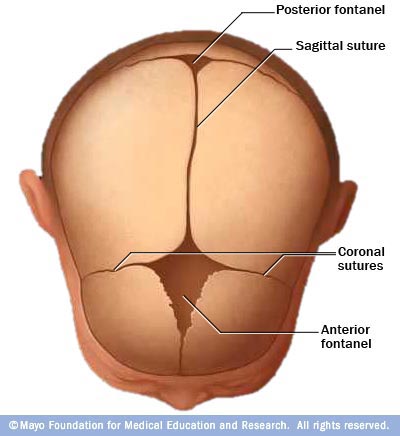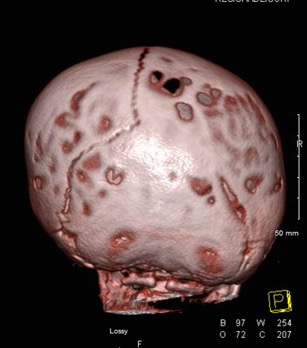 There are four types of craniosynostosis: sagittal, metopic, coronal, and bicoronal.
There are four types of craniosynostosis: sagittal, metopic, coronal, and bicoronal.
Sagittal synostosis is caused by the fusion of the sagittal suture, which runs from front to back down the middle of the top of the skull. This is the most common type of craniosynostosis. Characteristics include:
- a long narrow shaped head from front to back called scaphocephaly
- narrow from ear to ear
- the head appears boat-shaped
Metopic synostosis is the fusion of the metopic suture, which runs from the top of the head, down the middle of the forehead, towards the nose. Characteristics include:
- triangular shaped forehead called trigoncephaly
- eyes are closer together than usual if the lower suture near the eyes is fused
Coronal Synostosis is the premature fusion of one of the coronal sutures, which extend from ear to ear over the top of the head. Characteristics include:
- fusion of either the right or left side
- the forehead and brow look like they are pushed backwards
- the eye on the affected side has a different shape than the one on the unaffected side
- the eye on the affected side has a different shape than the one on the unaffected side
Bicoronal synostosis results when both coronal sutures fuse prematurely. Characteristics include:
- wide-shaped head, with short skull fusion that prevents the entire forehead from growing in a forward direction, causing a tall, flattened forehead
In severe cases, the brain is pushing out on the soft spot or anterior fontanelle.

|
Craniosynostosis
Procedure Information
|
|
Why did this happen?
At this time, doctors are unsure why craniosynostosis happens. In some families, it does appear to be an inherited trait. It is most likely that some mutation occurred in early development; however, results from recent studies are still inconclusive. There is no indication that there is anything the mother did or did not do to cause this.
Will this happen to children I have in the future?
The chances that other children will have this problem are between 0-4%. These are also the chances of your child's children being born with craniosynostosis. The only exception is when the craniosynostosis is a part of Crouzon or Apert Syndromes, in which there is a 50% chance of the condition being passed on from parent to child.
What kinds of problems could my child have?
Depending on the severity of the craniosynostosis, your child may have some or all of these problems:
- abnormal skull shape
- abnormal forehead
- asymmetrical eyes and or ears
- intracranial pressure (pressure inside the skull) which can cause delays in development or permanent brain damage if not corrected
Will my child need surgery?
Babies born with craniosynostosis usually will need surgery unless it is a very mild case. It is important that the proper X-rays and CT scans are made in order for your physician to make a correct diagnosis. The physician will also show you the fused sutures and how they will be reconstructed. Usually, only one surgery is required to separate the sutures, reshape the bones, and place them in the proper position. Only 10% of children will need a second surgery. Surgery to correct craniosynostosis is usually performed between four and eight months of age.
 CT demonstrating gaps in calvarial bone due to increased pressure from multi-suture synostosis.
CT demonstrating gaps in calvarial bone due to increased pressure from multi-suture synostosis.
Craniofacial Surgical Team
Plastic surgery works in concert with neurosurgery and ENT, In planning and performing the best procedure. In early detection, the fused sutures can sometimes be released using limited or smaller incisions called an endoscope. More advanced cases or cases late to be diagnosed are repaired with a more open procedure where the bone is expanded and plated with plates that are absorbable. In certain cases we elect to release the suture and place bone expanding devices that penetrate through the skin until the expansion is complete.
Am I alone?
No! There are many families and organizations who will be glad to talk with you and help you with information and support. Don't forget books, videos, and websites. The listing below will get you started.